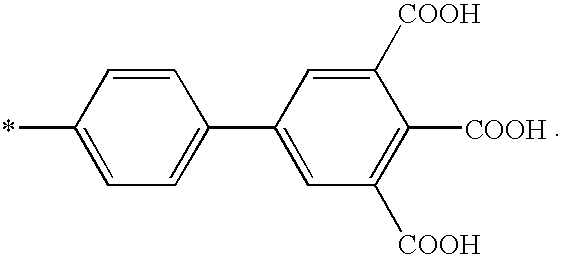Aryltricarboxyl-attached pigment-based inks with improved slewing decap
a technology of aryltricarboxyl and pigment-based inks, which is applied in the field of pigment-based inkjet imaging, can solve the problems of reducing the line quality and accuracy of certain pigment-based ink-jet inks, wasting ink-jet inks, and unable to meet all of the above characteristics
- Summary
- Abstract
- Description
- Claims
- Application Information
AI Technical Summary
Problems solved by technology
Method used
Image
Examples
example 1
Ink Vehicle Preparation
[0040] Two ink-jet ink vehicles were prepared in accordance with Table 1, as follows:
ComponentInk vehicle type 1Ink vehicle type 22-pyrrolidone10wt %16wt %1Decap friendly cosolvent10wt %42Other cosolvent2wt %2wt %Fluorinated surfactant0.0075wt %0.0075wt %Acetylenic dispersant0.15wt %0.15wt %Tris(hydroxymethyl)aminomethane0.10wt %0.10wt %Styrene polymeric dispersant0.70wt %0.70wt %WaterBalanceBalance
1High boiling point cosolvents that are readily dissolvable in water, including cosolvents are generally used in the art to improve decap performance. Examples include glycerol, diethylene glycol, triethylene glycol, polyethylene glycol, dipropylene glycol, tripropylene glycol, Dantocol DHE, ethylhydroxy methylpropanediol, 1,2-pentanediol, 1-(2-hydryoxyethyl)-2-imidazolidinone, N-methylmorpholine-N-oxide, tetraethylene glycol, 2-methyl-1,3-propanediol, mixtures thereof, etc.
2Standard cosolvents often used in the thermal ink-jet ink arts. Examples include liponic...
example 2
Slewing Decap Performance
[0041] Slewing decap performance tests were conducted using various ink formulations containing pigment with structure of Formula I and Ink vehicle type 1 and Ink vehicle type 2 by allowing multiple predetermined slewing times to occur (e.g., 1 second, 2 seconds, 3 seconds, etc.) prior to printing a thin line with crisp edges. As capping typically causes clogging or misfiring of jetting orifices, when capping has occurred, line quality is significantly reduced. Each of the printed characters is compared to determine whether acceptable print quality was achieved. Any noticeable failure in the crispness of the line is considered to be failure. The slewing decap time is determined by evaluating the lines the have acceptable print quality compare to the lines that have unacceptable print quality. For example, if a line has acceptable print quality after 5 seconds of stewing, and unacceptable print quality after 6 seconds of slewing, then the slewing decap time ...
example 3
Slewing Decap Performance for Arylmonocarboxyl-, Aryldicarboxyl- and Polymer-Attached Pigments
[0043] Slewing decap performance tests were conducted as above using various ink formulations containing arylmonocarboxyl-, aryldicarboxyl- and polymer-attached pigments in Ink vehicle type 1 and Ink vehicle type 2. The slewing decap time of these inks were found to be at least 6 seconds. No decap difference was observed for inks with Ink vehicle type 1 and Ink vehicle type 2. This indicates that the 2-pyrrolidone requirement for decap performance is not necessary for polymer-attached pigments and pigment types where there are less than three carboxyl groups present on a common aryl group.
PUM
| Property | Measurement | Unit |
|---|---|---|
| wt % | aaaaa | aaaaa |
| wt % | aaaaa | aaaaa |
| wt % | aaaaa | aaaaa |
Abstract
Description
Claims
Application Information
 Login to View More
Login to View More - R&D
- Intellectual Property
- Life Sciences
- Materials
- Tech Scout
- Unparalleled Data Quality
- Higher Quality Content
- 60% Fewer Hallucinations
Browse by: Latest US Patents, China's latest patents, Technical Efficacy Thesaurus, Application Domain, Technology Topic, Popular Technical Reports.
© 2025 PatSnap. All rights reserved.Legal|Privacy policy|Modern Slavery Act Transparency Statement|Sitemap|About US| Contact US: help@patsnap.com


